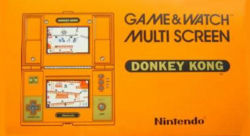Donkey Kong (Game & Watch)

| |
| Donkey Kong | |
| Developer | Nintendo R&D 1 |
| Publisher | Nintendo |
| System | Game & Watch |
| Release Date | June 3, 1982 |
Donkey Kong is a Game & Watch game based on the arcade game of the same name. It is one of the first games released in the Multi-Screen format.
Information[edit]
As in the arcade game, the player controls Mario as he navigates a construction site to rescue Pauline from the dreaded Donkey Kong. The Game & Watch game acts somewhat like an extended version of the arcade game's first level. Mario has to work his way up a series of girders while dodging the barrels tossed by Donkey Kong. Mario then had to flip a lever which would temporarily activate a crane. Mario had to leap and grab onto the crane to disconnect one of the wires holding up the girder where Donkey Kong rested. Mario was then returned to the start of the stage, and the pattern would continue until all the wires holding up the platform disconnected, causing Donkey Kong to take a fall.
Rereleases[edit]
- In 1998, Donkey Kong was released on the Toymax's keychain-bearing Mini-Classics line.
- Donkey Kong was also included in Game & Watch Gallery 2.
- Like most games in the Game & Watch Gallery series, Donkey Kong could be played in its original “Classic” mode or a new “Modern” mode. In the Modern version, Mario and Donkey Kong were changed to resemble their current appearance in video games (complete with Donkey Kong’s trademark tie). Additionally, Pauline was replaced with the more recognizable Princess Peach. Instead of the girder level, there were three levels set in a factory, a jungle and the sky. Red Koopa Troopas and Paratroopas were also added into the game.
- Both the Classic and Modern versions of Donkey Kong also appeared as unlockable games in Game & Watch Gallery 4. They were basically the same as they had been in Game & Watch Gallery 2, except for the improved Gameboy Advance graphics.
- Finally, the retro version of Donkey Kong was one of the Multi-Screen games included on Game & Watch Collection, which took advantage of the duel screens of the Nintendo DS.